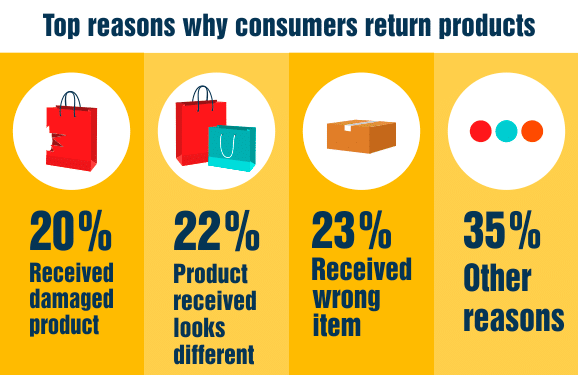Reverse Logistics: Why returns create challenges?

Presently an increasing number of online retailers are optimising their return policies. These updated policies allow customers who are dissatisfied with their purchases to easily return their items with reverse logistics.
Despite the additional costs for re-deliveries, making returns easier builds loyalty and creates positive word of mouth. Consequently, the impact of a good returns policy makes customers more willing to buy products and engage with brands. A smooth reverse logistics essentially lowers the purchase barrier for first-time customers.
Why customers desire an easy E-Commerce returns process?
E-Commerce returns encompass the entire process to return a purchased item, from the online experience and logistics, to refunds. Each retailer has specific terms and conditions for their product returns procedure. Let’s first dive into the problems causing the demand for online returns.
30% of the products that are purchased online are returned, in contrast to 8.89% for brick-and-mortar stores. The main reasons for these returns are; receiving the wrong item (23%), difference in appearance from the actual product (22%) and receiving damaged products (20%)[1].


Looking at these statistics we can conclude that there is a high demand for E-Commerce returns. It’s safe to say that well-established retailers should offer a simple returns option to their customers to fulfil their needs.
In addition, with these simplified returns policies retailers bring about higher customer satisfaction and retention rates, leading to long-term revenue through re-purchases. This signifies a tremendous growth of customers which naturally benefits companies.
However, despite the positive sales impact of an easy returns policy, many online retailers point out that returns cause reverse logistical challenge. Key issues retailers point out are the disruption of inventory management and warehouse efficiency, issues in the re-routing process, and the handling costs.
The following points explain how the challenges of reverse logistics can be resolved:
The interruption of supply chain
The returns process affects the normal logistic supply chain. Once customers return their E-Commerce orders, retailers have to proceed a series of actions to maintain their operations and avoid interruption.
Firstly, retailers need to identify returned packages, ensuring proper matching with the original order. The entire process is labour- intensive, challenging, and requires an ‘assembly line’ to process all the inbound items effectively.
After this step, retailers decide whether to permit a product exchange or not. Some return requests are accepted with valid reasons whilst others are not due to a breach of regulations. This procedure should be executed based on the retailers returns policy. Lastly, a product exchange may be shipped if the return request has been validated, and if the customer desires another product.
66% of customers are satisfied with ‘a clear and easy return policy’, and 92% of them will purchase again if the return process is easy [2][3]
Alternatively, and potentially easier, online retailers can outsource their reverse logistics to a third-party logistics provider (3PL) to help them manage all cross-border transactions and redelivery orders. The logistics provider ensures end-customers receive the exchanged items without delay. Customers should also be able to track their replaced orders and receive updates tracking updates.
To conclude, good reverse logistics providers offer a holistic service which provides good customer visibility and data analytics. Data is extremely useful to track where returns come from, why people are returning and to identify the most frequent returned products. Naturally, this gives insight into product design complications and customers’ buying preferences which can improve sales in the long term.
Click here to learn 5 types of supply chain interruptions and how to solve them!
Increased inventory and warehouse burden
Due to returns, the burden on warehouse inventory also increases. A returns process requires a lot of time and effort, which is why many retailers initially did not want to invest in a return policy. As a result, the lack of investment increases the burden on warehouses and a higher chance of data-entry errors.
To prevent inventory issues, online retailers should implement a retail inventory management system for returns. Here are three important elements to focus on:
- Verify incoming returned orders and input data accurately into the inventory system.
- Inspect returned items to see if they are defect or damaged and potentially route them for repairs. Barcodes have to be inserted and finally products need to be re-delivered to customers.
- Determine dead stocks such as damaged goods and incorrect deliveries as extra inventory weighs on profitability. Retailers are recommended to place leftover products into one place, designate a stock sheet and regularly remove them from inventory.

Click here to view the guide of setting up a retail inventory management system:
Time and damage costs
Time and damage costs are another re-occurring issue. Inspecting, repairing and redelivery processes cost money. The global product returns volume has mounted in recent years. One in three products bought online is intentionally purchased for testing and comparison before being returned [4].
As a result of increasing return volumes, companies are struggling to effectively assess product failures/damage and are faced with repackaging and redistribution costs.
The National Retail Federation and Software solutions provider Appriss Retail confirmed that they spent USD$369 billion for reverse logistics in 2018 [5]. These figures confirm well-rounded returns policies with effective inventory management are needed to reduce costs and maximise profits.
Digitization, and therefore online shopping, are here to stay. Despite the difficulties in inventory management and handling costs, it is essential that retailers invest in a strong E-Commerce return strategy. As a result, customers are more engaged with brands without worrying about refunds or the hassle of product returns. Statistics point out that returns are a crucial component in online retail retention strategies, which is why a holistic returns policy strongly contributes to a company’s bottom line.
Click here to learn how our E-commerce service provide businesses with returns solutions:
Click here to view the returns case study from Rebound Returns.
[1] (Saleh, 2011). “E-Commerce Product Return Rate – Statistics and trends”. Invesp Organisation.
[2] (Saleh, 2011). “E-Commerce Product Return Rate – Statistics and trends”. Invesp Organisation.
[3] (NChannel, 2017). “Reverse logistics: Where online retailers should make improvements?”.
[4] (American Express, 2021). “The rising impact of reverse logistics on E-Commerce”.
[5] (American Express, 2021). “The rising impact of reverse logistics on E-Commerce”.


